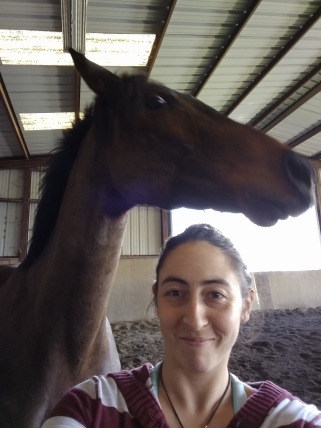Since Twin, I’ve been thinking about what I might be able to do for Murray to make him more comfortable and extend our competition career. A part of what inspired me to start thinking about it more seriously was his super-stardom at Twin, but I also have a lot more income than I ever have in the past. This makes entertaining the idea of spending/potentially wasting money on my horse’s well-being possible — I literally* did not have the money to pour money into joint maintenance before.
* The actual literally, not the millennial “literally” that really means “figuratively” or “maybe”
I first heard about Pentosan on Amanda’s blog (like, where I hear about most things apparently), and after following the trail of evidence she left, I wasn’t terribly convinced. Use of the drug was based mostly on anecdotal reports of improved movement and comfort after IM/IV injections among Australian horse owners, and there wasn’t a ton of peer-reviewed evidence to back up using Pentosan IM/IV for joint maintenance.
Pentosan, if you’re unfamiliar, is a semi-synthetic polysulfyated xylan (don’t know what that really means? me neither!). It is used for several purposes, including treatment and prevention of osteoarthritis. The most interesting thing, to me, about pentosan is that it is used during open-joint surgery to help heal the joints after they are put back together. Literally, surgeons squirt the stuff all over the open joint to help avoid cartilage break down and improve synovial fluid viscosity. edit: Austen pointed out to me this important clarification: joint lavage (which is done both surgically or arthroscopically) works by helping to wash away debris that accumulates in the joint and may cause pain (at least in humans). Therefore, the pentosan may not be having as much of an effect as might be reported — the lavage process itself is extremely helpful in this case.
I’m won’t rule out a treatment or medication as ineffective simply because it doesn’t have veterinarian or peer-reviewed evidence. I know that it takes time to conduct studies and gather data, and that what is currently being studied may not be what is in vogue with horse owners at the time. Joint pain and comfort is terribly hard to quantitatively evaluate, especially when you want to look at more than just the articulation of a specific joint (how far that joint can flex/bend), and supplements/drugs for joint pain in companion and production animals aren’t necessarily at the top of the research ladder. Particularly in equines, the amount of scientific inquiry into the efficacy of drugs or supplements is quite sparse.
All that said, I’m not going to rush out and spend a lot of money on a product that is anecdotally reported by horse owners to make their horses “feel better”. The placebo effect*, even among animal caregivers and owners, is a real thing. (Also in 2014 my horse was five, not actually mine, and it wasn’t the time to think seriously about maintenance.)
* Have just realised this could make an incredible horse name!!
 placebo effect is sooooo good at canter poles
placebo effect is sooooo good at canter poles
When I started thinking about and exploring joint maintenance for Murray this year, pentosan popped up both on the interwebs and at the suggestion of a friend. I took some time to look into the drug more seriously, and found that in the last three years, enough evidence about the efficacy of pentosan in prevention and treatment of OA has accumulated to convince me it’s worth a try. If you’re interested in my research, just hit me up and I can share the details with you. But here are some of my more general findings. (Links here may be behind a paywall.)
First of all, pentosan appears to be safe to use in horses both intra-articularly (i.e. joint injections), as well as IV and IM. That’s great, because it means that you don’t have to pony up for expensive IA injections just to get the drug, an if you can’t do IV, you can safely go IM.
There is also good evidence that IM pentosan actually makes its way into both the plasma (blood) and intra-articular spaces (joints). And in dogs, pentosan has been used to successfully treat chronic osteoarthritis. If you want to dive a bit deeper into the cell-biology literature (exposing oneself to some serious jargon at the same time), there’s at least one proposed method for pentosan to treat osteoarthritis by acting as a chondroprotective agent (cartilage protective agent).
Pentosan was demonstrated to modify the healing of experimentally-induced OA in donkeys and horses. In these studies, donkeys and horses with experimentally induced OA were given IV pentosan (treatment) or saline (control). At the beginning of the treatment period, all animals were lame, and their levels of lameness, synovial fluid, cartilage damage, and the levels of certain elements (Mg, Ca) were tracked over time (among other factors associated with joint health). All of the above mentioned factors improved significantly in treatment animals, i.e. synovial fluid was decreased compared to controls, cartilage damage was less. Most importantly to me, lameness score in treatment animals decreased to baseline (which I believe was 0) after pentosan treatment, whereas in control animals lameness score decreased, but never achieved baseline levels.
Certainly, this is a pretty extreme way to check the utility of pentosan. And it doesn’t necessarily speak to the maintenance side of the drug, or how pentosan interacts with joints that might have mild-moderate OA. Notably, a similar study using pentosan and hyaluronic acid was inconclusive and demonstrated no improvement with treatment. So there is still plenty of room for skepticism. However, if the proposed relationship between increased synovial fluid and cartilage degeneration in osteoarthritis is correct (an extremely reasonable and supported assumption), and pentosan really does decrease synovial fluid and help decrease cartilage damage, then it seems reasonable that pentosan may help prevent or mitigate osteoarthritis (by mitigating cartilage damage and preventing the forces that result in increased synovial fluid).
There are still lots of “ifs” here. But I’ll definitely be talking to my vet about pentosan in the coming weeks.



I love all the research you’ve posted here! I can tell you that we’ve used it on a couple with very good results. Always IM, which makes giving it very easy… most recently, on a horse with some sourness/nappiness under saddle with a lot of tension over his top line… the physical effect on him has been quite noticeable — as in, he’s been feeling VERY good! Feel free to message me about specifics:)
LikeLike
I will!!
LikeLike
i only have anecdotal knowledge of pentosan…. right along the lines of most of the folks i know who use it report noticing a difference with it. regardless i’ll be curious to hear what comes of your conversation!
LikeLike
I really appreciate your scientific approach to this. There isn’t nearly enough science involved in a lot of horse related decisions, partly because so many things don’t have good research available, but it’s certainly good to search out the information when it does exist. I may need to look into pentosan myself now.
LikeLike
The lack of science makes me craaaazy! So I’m glad you appreciated it. 🙂
LikeLike
I’ve heard really good things about it from friends but also heard that it was really tough to get since it wasn’t FDA approved at that point. I knew that some vets would proscribe it but others wouldn’t. I’m curious if it’s easier to get now.
LikeLike
There is at least one place I know of to get it off-prescription. I wouldn’t order without my veterinarian’s approval, personally. But one can certainly get it.
LikeLike
Put me in the positive anecdotal experience column as well.
Two things to add: Adequan (100mg/ml) 50 ml is around $400 while Pentosan (250 mg/ml) 100 ml comes in at $160. For me at least, the dosing has been the same. Also, Pentosan is contraindicated when the horse has been on anti inflammatories as it thins the blood temporarily.
LikeLike
Thanks for much for sharing this! It’s quite timely as my older gelding is struggling with some stiffness and I’m planning a convo with my vet very soon, curious what his thoughts are 🙂
LikeLike
Interesting. I’ll have to add this one to my list of potential solutions for Nilla.
LikeLike
I also have great personal experience with it. There’s a noticeable difference in Tristan’s lateral work and suppleness when he’s due for a dose. He gets it monthly right now.
My vet, who was first in her class at UC Davis and is a “stay up all night reading all the studies” kind of person, likes it. I’m a “ewwww, science” person, so between us, I figure it’s working out. 🙂
LikeLike
Thanks for delving into the research! I’ve been using Pentosan for Dino since last summer and it’s made a positive difference for him – I can definitely feel when he needs another dose and have noticed improvement in his movement and willingness to use his hocks & stifles properly. It’s also WAY cheaper than Adequan and proven to be quite safe, so worth a try IMO!
LikeLike
I’ve been using Pentosan for about 3 or 4 years and I do think it makes a difference. I put Mia on it last year and I do think her hock mobility has increased, others comment that she seems to have even more flexibility now as well. I hope it works for you too, it is MUCH cheaper than other alternatives (Adequan, Polyglycan, etc).
LikeLike
Um that last image is pure brilliance.
LikeLike
Thanks for sharing this wealth of information. Something to think about for sure.
LikeLike
Definitely let me know how it goes. Ryon’s jumping career was cut off by osteoarthritis, my mare just got her hocks injected, and anything that would increase both of their mobility would be awesome.
LikeLike